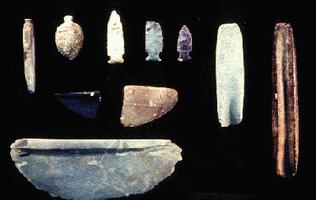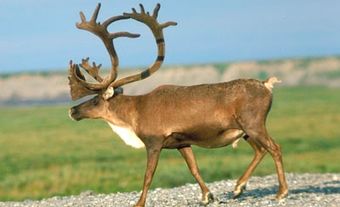Palaeoindian
The Palaeoindian culture comprises several cultural manifestations spanning 4000 years, from 12 000 years to 8000 years Before Present (BP). This period is generally divided into two distinct cultural episodes: Early Palaeoindian (12 000-10 000 BP) and Late Palaeoindian (10 000-8000 BP). However, this chronological division is arbitrary and towards the end of the Late Palaeoindian period, some regions were the scene of early events associated with the Early ARCHAIC period.Some discoveries at the BLUEFISH CAVES and the OLD CROW BASIN in the Yukon trace back the occupation of these two deposits at around 25 000 to 40 000 years BP, based on dates obtained from sediments and mammoth bones that have most likely been modified by humans. These findings remain isolated, however, and it is likely that most of the earliest humans from East Asia crossed BERINGIA and set foot in the Americas less than 15 000 years BP. First known as the Northwest Palaeo-Arctic culture, evidence of their presence were mainly found in Alaska and the Yukon and included typical tools such as microblades, burins and bifaces.
Early Palaeoindian
Later, the descendants of Palaeo-Arctic groups undertook a long journey, bypassing the ice mass that covered most of Canada during this period (seeICE AGE) and reaching Eastern Canada around 12 000 BP. There are very few sites from the Early Palaeoindian period, and most of those discovered are located in southern Ontario and Nova Scotia.
The lithic industry of the Early Palaeoindians differed from that of their predecessors, the Palaeo-Arctic, in that they made lanceolate projectile points of the CLOVIS type, usually from chert or chalcedony. These points were fluted and could be hafted to the extremity of a lance. The presence of this typical hunting tool allows archaeologists to easily identify the components or sites associated with this period.
In addition to projectile points, the Palaeoindians had a variety of other stone tools, mainly scrapers and knives to handle carcasses from which they obtained food and made clothing suited to the harsh climate that prevailed at that time. The groups that occupied Western Canada belonged to another cultural tradition that manufactured pebble tools and microblades.
The Early Palaeoindians lived in a tundra environment, on the fringes of deserts left by retreating glaciers. They lived in small, highly nomadic groups composed of a few families and probably totaling less than 20 individuals, and moved over large areas based on the availability of food resources. Although megafauna remains, including those of mastodons and mammoths, were found on sites from this period in the State of New York, their subsistence was most likely based on the hunting of big game, especially CARIBOU and BISON in Western Canada, and occasionally small mammals such as the Arctic FOX and the HARE. They also occasionally fished, for SALMON on the West Coast.
The Palaeoindians were skilled hunters, especially since they only had a rudimentary hunting technology consisting of a simple spear topped with a stone point to face animals like caribou, which possess a fine hearing and a particularly well-developed sense of smell. When pursued, caribou can reach a top speed of nearly 60 km per hour and maintain a pace of 40 km per hour for nearly an hour. Yet, the Palaeoindian hunters were successful in getting their favorite game by tricking the animals and using natural traps, such as suggested by the environmental context of the DEBERT SITE in Nova Scotia.
Late Palaeoindian
The groups associated with the Late Palaeoindian period (about 10 000-8000 years BP) shared the same lifestyle as their predecessors, but at a time when the climate was much more favorable and gradually less influenced by the northern regression of the continental glacier.
Their toolbox included slender and regular lanceolate projectile points with parallel-sided flake scars (known as Plano points). Drills, bifacial tools, scrapers and abraders are also present in the lithic assemblages found on sites from this period. Chert was still the main raw material used by these groups.
Although caribou was still part of the subsistence, particularly in Eastern Canada, bison is one of the best-documented species on sites located in the Canadian PRAIRIES, where evidence of slaughtering sites were found, at the EDEN HERON SITE for instance. The diet of the Late Palaeoindians also included small mammals, based on the availability of regional resources. Sites from this period are mostly found on terraces near the margins of proglacial lakes (which develop from meltwater along the front of glaciers) in the western prairies, northern Ontario and the St Lawrence River estuary.
As the climate became less restrictive and vegetation started to colonized freshly emerged lands, Palaeoindian groups gradually regionalized and adapted to their new environment. These conditions gave way to a period of greater stability, which saw the emergence of the Archaic culture.
See alsoPREHISTORY.

 Share on Facebook
Share on Facebook Share on X
Share on X Share by Email
Share by Email Share on Google Classroom
Share on Google Classroom




